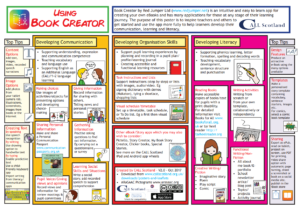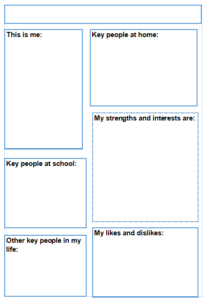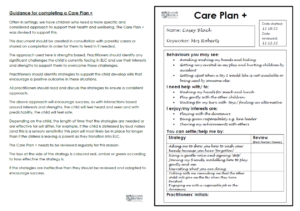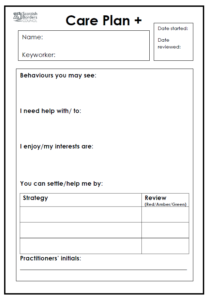Personal Plans
Additional Support Needs (ASN)
What is it?
“All children and young people need support to help them learn. Through good quality learning and teaching, staff in early learning and child care settings and schools are able to meet a diverse range of needs without additional support. Some children and young people will require support that is additional to, or different from, that received by children or young people of the same age to ensure they benefit from education, whether early learning, school or preparation for life after school. There are many reasons why children and young people may need support to help them learn. Additional support needs can be both long- and short-term, or can simply refer to the help a child or young person needs in getting through a difficult period.”
(What are additional support needs?, Education Scotland: Parentzone, 2021)
There are many things practitioners can and should do to enhance their ‘Universal’ approach alongside more specific or targeted strategies. This will have a positive impact on many others within the setting too.
Key messages:
‘Child-first’ approaches should underpin consideration of the following aspects of practice:
- Practitioner knowledge and understanding is current and reflective of the needs of the children in their setting. It is inclusive of:
- Child development
- Curriculum
- Individual approaches to meet additional needs
- Specific research related to identified additional and individual needs
- Local and national authority guidance and legislation.
- Inclusive resources are plentiful and used to maximise opportunities and learning responsive to the individual.
- Choice – where, when and how.
- The child’s voice is listened to, valued, responded to, and visible.
- Respectful and nurturing behaviour modelled.
- Considered transition routines that reflect individual needs.
- Family and partner agency links are valued, visible, strong and purposeful.
- Awareness of when and how to seek out further support if needed.
Ways we can do this:
Practitioner Knowledge and Understanding: Practitioners have current knowledge and understanding of child development, including attachment theory, schemas, self-regulation, and the theory underpinning Emerging Literacy and English, and Early Mathematics and Numeracy.
Practitioners have current knowledge and understanding of the curriculum, which reflects the needs of the children in their setting. They may use Developmental Milestones for children with complex additional needs, where applicable.
Practitioners create personalised progressions and plans in collaboration with parents, carers, and allied health professionals, such as Occupational Health, Speech and Language Therapy, specialist services such as Leader Valley Autism Outreach, Home Visiting Teachers, or Specialist Teachers (see Professional Partnerships and Specialist Services below for more information).
Practitioners use individual approaches to meet additional or individual needs, which may include the use of:
- Visual Supports
- Sign-a-long (NHSBorders SaLT)
- Additional time to support co-regulation and self-regulation using restorative approaches
- Having access to an alternative space as required
- Social stories help support an individual’s understanding of emotions, routines and behaviours. Book Creator can be used in creating these resources.
Practitioners are proactive in seeking out specific research related to identified additional and individual needs, such as Developmental Language Disorder, Autism, and auditory or visual impairment.
Practitioners are knowledgeable about and use local authority and national guidance and legislation. Having skilled practitioners with good knowledge and understanding will ensure higher confidence levels in identifying when children may need additional support and supporting them to achieve their potential. Practitioners should identify gaps in professional learning, feel secure, and be helped to find and engage with high-quality training and support from partner agencies.
Inclusive Resources: Practitioners ensure that inclusive resources are available and used to support children’s individual needs and educate others, e.g. books that positively represent equity and diversity, including illustrations of children with visual impairment, using a wheelchair, or non-visual needs.
Effectively levelling resources throughout the environment will support meeting all children’s needs.
Practitioners must ensure that the environment is purposefully and critically reflected on, adapted to include ‘reasonable adjustments’ to support access to resources and experiences where needed. When considering the environment concerning additional needs, many aspects should be explored:
- Emotional: See Nurture and Restorative Approaches.
- Physical: Considering sounds, smells, lighting, layout and displays. Particular attention should be paid to visuals within the classroom, as a decluttered, visually calm space will support a calm atmosphere.
- Routines: Consistent daily routines may help children anticipate what comes next and support them in feeling safe. Visual schedules, timetables or choice boards with consistent imaging supports all children to feel safe because they know what to expect throughout the day. Now Next (Small)
Lower primary individual visual timetable
Auditing the environment and making ‘reasonable adjustments’ to meet individual needs will benefit the specific child and positively impact all children – see Audits Portal page for examples.
Choice: Practitioners provide children with choices of where, when and how they engage with their learning. For example, when the need is observed, children choose when and how to participate during gather times. Practitioners are responsive and provide meaningful opportunities as an alternative when needed.
In Realising the Ambition, (Education Scotland, 2020), participation and agency are discussed,
“Children have a sense of agency over the organisation of the setting and the experiences within it. They have the ability to decide whether to/how to take part in experiences with free-flow access to outdoor play and resources that are easily accessible for them.” (p. 68)
Child Voice: Practitioners should ensure that the child’s voice is listened to, valued, responded to, and visible using inclusive communication methods, such as gestures sign-a-long, visuals and Picture Exchange Communication System (PECS). Please note that PECS is a specific approach that must be used with guidance and training from Speech and Language Therapists in a coordinated and planned way.
Initially, practitioners should use object signifiers (real objects) to give children choices, e.g. jugs of milk or water, before using a visual representation and/or sign, e.g. photos or Boardmaker symbols on choice boards. These reduce the potential of being overwhelmed.
A Communication Passport or a Care Plan + are also helpful tools (see below for more information).
Nurture: Practitioners must ensure that respectful and nurturing behaviour is modelled at all times and the setting has a shared understanding that all behaviour is a form of communication.
SBC Nurturing Approaches should be used; and, where appropriate, viewed through a different lens, as suggested in guidance from the National Autistic Implementation Team.
Considered Transitions: Practitioners ensure ‘vertical’, and ‘horizontal’ transition routines reflect individual needs by using appropriate resources such as Now and Next visuals and timetables (as above).
When a child has been identified as having additional needs, the transition from Home to ELC and ELC to P1 must be planned, coordinated and progressive and begin at least six months before the transition point. The creation of a Communication Passport at this point may help to gather key relevant information.
“Consideration should be given to any reasonable adjustments to the physical environment to support effective transitions. Enhanced transitions arrangements must be planned and coordinated to include input from parents/ carers and any specialist or targeted services as needed.”
(Realising the Ambition, Education Scotland, 2020, p. 95)
Family and Partner Agency Links: Practitioners must ensure that, from the outset, family and partner agency links are valued, visible, strong and purposeful. These links must be evident in any meeting minutes (Individual Education Plan (IEP), Universal +, Meeting Around the Child (MAC), Coordinated Support Plan (CSP)). Other collated documentation such as Care Plans and Chronologies, All about Me pages, and learning journeys should detail planned interventions and their impact on improving outcomes for the child. All practitioners must have a working knowledge of data protection, confidentiality and all other legal requirements and apply this knowledge when working with families and partner agencies.
Practitioners should seek out further support concerning additional needs if necessary. Settings should have an organised approach to this. There is a shared understanding of where, when and how to access training, professional reading and research, Support for Learning participation, allied health professionals, and specialist partner services.
Please see the tabs below for further guidance on allied health and specialist services.
Linked Areas of Practice
Children’s Rights
Child First
English as an Additional Language (EAL)
Gender Equality
Inclusion
Keys to Communication
Nurture
Observations
Personal Plans
Professional Partnerships & Specialist Services
Responsive Planning
Self-Regulation
Sensitive Interactions
Sensory Processing
Transitions
Tools
Reflecting on Practice
SBC Guidance to support
National Guidance to support
Further Reading to support
Training to support
Specialist Services
For further information on the Specialist Services available in Scottish Borders Council, please see the Professional Partnerships & Specialist Services page.
Print-outs
- Book Creator – Call Scotland
- Personal Passport Example
- Care Plan + with Guidance
- Care Plan + (editable)
Often in settings, we have children who need a more specific and
considered approach to support their health and wellbeing. The Care Plan +
was devised to support this.




